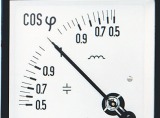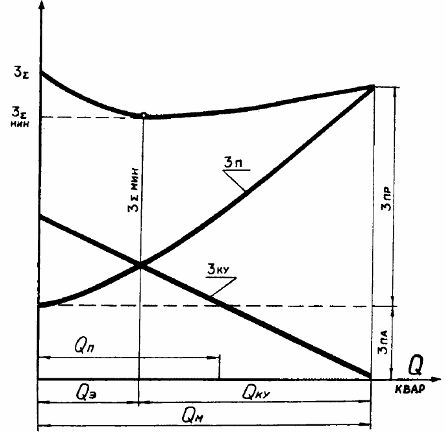The economic nature of reactive power compensation
 For technological lines, departments, workshops of industrial enterprises, reactive loads, as a rule, are more active. The consumption of reactive power exceeding economic values leads to a decrease in the performance of all elements of electrical networks, additional losses of voltage and energy. The consequences of this:
For technological lines, departments, workshops of industrial enterprises, reactive loads, as a rule, are more active. The consumption of reactive power exceeding economic values leads to a decrease in the performance of all elements of electrical networks, additional losses of voltage and energy. The consequences of this:
-
the need to increase the power of power transformers, cross sections of conducting elements,
-
increase in the price of electricity,
-
reducing its quality, voltage level and performance of electrified technological lines and other electrical equipment.
Under operating conditions, in order to reduce the consumption of reactive power, a number of technical measures are applied: replacement of low-load asynchronous motors with lower power, limiting the operation of the motor at idle speed, welding transformers, etc. Such measures improve the operation of networks, but do not provide the most economical modes of power supply and energy consumption.This is achieved by using compensating installations.
See from previously published on the site: How to improve power factor without compensating capacitors
What is the economic sense of reactive power compensation? In the absence of compensating installations, the consumed reactive power Qm is maximum. The maximum and caused by the consumed reactive power losses of energy, voltage, the maximum costs Zp caused by the need to compensate for these losses (see Fig. 1).

Rice. 1. To justify the economic essence of the consumed value of reactive power
When installing a compensating device, the consumption of reactive power is reduced, but this requires the costs of ZKU to purchase, install, maintain the compensating device. The reduction of energy losses, the improvement of the voltage quality occurs throughout the service life of the compensating device, therefore, when evaluating the total, total costs of Z∑ = Зку + Зп, the one-time costs of installing the compensating device lead to annual, multiplied by the standard efficiency factor.
At a certain value of the reactive power Qe, the total costs of Z∑ turn out to be minimal. The economic value of Qeqap and (or) the corresponding reactive power consumption is determined (set) by the power supply organization. When the reactive power consumption is equal to Qe, an economical mode of operation of the power networks is ensured.
The power supply organization incentivizes the achievement of such a regime by applying a reduced fee for reactive power consumption.
Reactive power compensation and voltage quality
As the load increases, the supply voltage losses in the distribution networks. To compensate for them, the voltage in the area of substations, energy centers of enterprises with the help of transformers with load switches automatically increases, and when it decreases, they decrease (counter voltage regulation).
During periods of intermediate loads, the voltage level is linearly dependent on the actual load. The main load of industrial enterprises is asynchronous motors. Their reactive power consumption increases sharply with an increase in the voltage level at their terminals. Therefore, voltage regulation and supply and distribution networks (transformers with load switches, step-up transformers, other technical means) with a lack of compensating devices in consumer networks (reactive power deficit) are not efficient.
When reactive energy is consumed, this is a technically permissible limit (more than Qp), the power system is not responsible for the voltage quality. The power supply organization maintains during the highest and lowest charging time of the installed voltage levels specified in the contract only when the compensation requirements are met, i.e. when power compensating devices in corporate networks.
Users of low voltage in networks with a practically homogeneous load, the necessary voltage quality is provided by the counter regulation in the center of the power loads and the correct positioning of switches of power transformers of commercial substations. It is recommended, in accordance with the actual loads, to check and, if necessary, adjust the position of the switches of the power transformers quarterly. All calculations are recommended when This should be done in an automated way. In networks with significant load inhomogeneity, capacitor banks are used not only for compensation, but also for voltage regulation.
